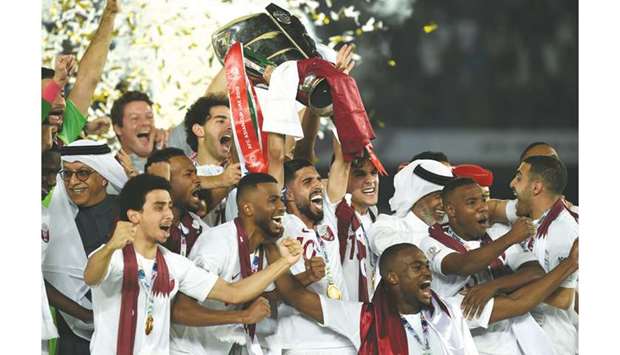It was a decade of change, growth and unforgettable memories for men’s football across the world’s most populous continent.
Two first-time AFC Asian Cup winners, four new club champions and a galaxy of new Asian stars meant the 2010s produced countless classic moments and footballing landmarks from both established and developing nations.
Three Asian Cups, two new Champions
The AFC Asian Cup grew from 16 to 24 teams and added two new winners in a transformative decade for Asian football’s flagship tournament.
After Iraq ended the previous decade as Asian champions following their stunning 2007 triumph in Southeast Asia, Japan claimed a fourth title in 2011, before Australia and Qatar both carved out pieces of history by claiming glorious maiden Asian titles in 2015 and 2019 respectively.
Hosted by Qatar, the 2011 tournament delivered countless memorable matches, culminating in a star-studded finale between Japan and Australia at Doha’s Khalifa International Stadium.
After 120 high-quality minutes of football, it was Alberto Zaccheroni’s Samurai Blue who prevailed, with Tadanari Lee’s spectacular extra-time volley sealing the title for a side blessed with the likes of Keisuke Honda and Shinji Kagawa.
Having narrowly missed out on a first Asian title, Australia atoned for their Doha defeat when they achieved a breakthrough win in front of 76,000 roaring fans on home soil four years later.
With ultra-attacking head coach Ange Postecoglou at the helm, the Socceroos piled on 14 goals in six matches, but it was James Troisi’s 105th minute extra-time winner against Korea Republic which proved decisive after Son Heung-min had scored a dramatic injury-time equaliser to silence the crowd just minutes earlier.
Australia’s other goal scorer in the final, 22-year-old midfielder Massimo Luongo, took the tournament by storm, producing a series of superb performances to earn the title of Most Valuable Player.
The decade’s third and final AFC Asian Cup marked the dawn of a new era, with the competition growing from 16 to 24 teams ahead of the 2019 edition in the United Arab Emirates.
In keeping with the theme, a youthful Qatar stunned everyone by storming to an unexpected, yet thoroughly deserved maiden Asian title with seven consecutive wins, 19 goals scored and only one conceded.
It was a pair of 22-year-olds who stole the limelight, with striker Almoez Ali netting a tournament record nine goals, while Akram Afif laid on 10 assists as Felix Sanchez’s side swept all before them before beating Japan 3-1 in the final in Abu Dhabi.
10 years of stars: Asia’s world-beaters
The past 10 years have seen a galaxy of Asian stars shine brighter than ever, with several players from the continent establishing themselves as world class players on some of the game’s biggest stages.
Korea Republic star Park Ji-sung already had three English titles to his name when the decade began, but he was among the first Asian players to win a major European club title in the 2010s when he lifted the 2010-11 Premier League trophy with Manchester United.
While Park starred in England, Shinji Kagawa burst onto the scene in Germany, winning successive Bundesliga titles with Borussia Dortmund in 2011 and 2012, before becoming the first Japanese player to win the Premier League after joining Manchester United ahead of the 2012-13 season.
Kagawa’s Samurai Blue teammate Shinji Okazaki also won the English title during Leceister City’s remarkable 2015-16 campaign, while countryman Keisuke Honda won silverware in Russia for CSKA Moscow, before joining Italian giants AC Milan in 2014.
Iranian striker Sardar Azmoun was another Asian forward to star in Russia.
Still only 24, Azmoun has bagged over 60 goals for Rubin Kazan, FC Rostov and Zenit St. Petersburg, winning the Russian Premier League with the latter in season 2018-19; a title won by Uzbekistan’s Vitaly Denisov with Lokomotiv Moscow a year prior.
Despite beginning the decade as a 30-year-old, Tim Cahill remained Australia’s most recognisable footballing export for most of the 2010s, appearing for major clubs throughout the globe, scoring an unforgettable FIFA World Cup volley against the Netherlands, and notching a staggering 31 of his 50 international goals from 2010 onwards.
However, few, if any, had the impact of Korea Republic forward Son, who starred throughout the decade for clubs in both Germany and England.
Son went on to establish himself as an elite forward for Hamburg, Bayer Leverkusen and Tottenham, and winning the AFC International Player of the Year on three occasions. Son became the second Korean of the 2010s, after Park, to play in a UEFA Champions League final, in 2019, the same year he was nominated for the Ballon d’Or.
Growing the game: A decade of expansion
The expanded AFC Asian Cup was one of many examples of the game’s growth during the 2010s, with both club and international football experiencing a game-changing increase in opportunities for development.
For many nations, the expansion has created the opportunity to host the Continent’s biggest national teams in competitive home-and-away fixtures, with India, Cambodia, Indonesia and Malaysia among the teams tapping into their enormous support base on a meaningful and regular basis.
While the 2010 AFC Champions League featured a total of 37 clubs from 15 member associations, the 2019 edition included 51 clubs from 22 nations, with the AFC Cup field growing from 31 to 43 in the same timespan.
Asian club football’s growth is set to continue into the 2020s, with the AFC Champions League group stage to expand to 40 teams ahead of the 2021 edition of the continent’s most prestigious club football competition.
A decade of firsts: History-making clubs
Clubs, countries and entire regions tasted continental glory for the first time in a decade which saw Asia’s two major trophies shared far and wide.
Uzbekistan’s FC Nasaf got the ball rolling in 2011, when their 2-1 AFC Cup final win over Al Kuwait made them the first club from former-Soviet Central Asia to win a major Asian club title.
Chinese powerhouse Guangzhou Evergrande made their own history two years later, becoming the first club from the world’s most populous nation to become Asian champions in the AFC Champions League era, and only the second in history following Liaoning FC’s 1990 Asian Club Championship title.
The firsts continued in 2014, when Western Sydney Wanderers beat Saudi Arabia’s Al Hilal 1-0 on aggregate to become the first Australian club to win the AFC Champions League.
Malaysia’s Johor Daurl Tazim defeated Tajikistan’s FC Istiklol in 2015 to become the first club from Southeast Asia to win the AFC Cup, while Iraq’s Air Force Club would go on to claim an unprecedented three successive titles in the competition from 2016 to 2018.
Al Hilal closed out the decade with their 2019 AFC Champions League triumph.
Challenging the world: Asia on the world stage
The 2010 FIFA World Cup in South Africa promised much as both Japan and Korea Republic advanced from the group stage. Japan carried Asian hopes through to the Round of 16 in Russia in 2018.
Those three second round appearances were as good as it got for Asian sides at the FIFA World Cup, but teams from the continent became regular challengers in global youth finals.
Iraq reached 2013 FIFA U-20 World Cup semi-finals in Turkey, while a Korea Republic side inspired by Lee Kang-in charged all the way to the final of the 2019 edition in Poland.
Iran lit up the Asian futsal scene in the 2010s, winning three AFC Futsal Championships and finishing third at the 2016 FIFA Futsal World Cup.
Iran finished the decade as the second-ranked Beach Soccer team in the world, and finished third in the 2017 FIFA Beach Soccer World Cup.
Japan would follow in their footsteps two years later in Paraguay, reaching the global semi-finals, with only a penalty shootout defeat to eventual winners Portugal ending their bid for a maiden title.(AFC)

In this February 1, 2019, picture, Qatar’s players celebrate with the trophy after winning the 2019 AFC Asian Cup final against Japan in Abu Dhabi. (AFP)


